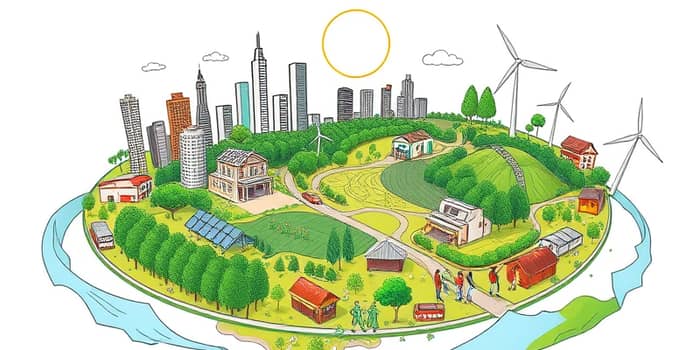
We live in a time when resource scarcity and environmental degradation challenge our way of life. The traditional linear “take-make-dispose” model has led to overflowing landfills, overexploited forests, and mounting carbon emissions. In response, the concept of a circular economy has emerged not only as an environmental imperative but also as a profound economic opportunity. By redefining how we produce, consume, and regenerate, this approach promises to unlock innovation, resilience, and prosperity. This article explores the key principles, economic potential, real-world applications, and strategies that can guide stakeholders toward a thriving, sustainable future.
A circular economy rejects the idea of waste and designs systems that restore and renew. At its core, a circular economy is a regenerative economic system that views materials and products as assets to be kept in use for as long as possible. Instead of exhausting resources in a linear fashion, it focuses on maximizing the value of resources through maintenance, upgrades, and recycling. This shift is restorative by design, aligning economic growth with ecological health and social well-being.
The framework rests on several interconnected principles that redefine value creation and consumption. By integrating renewable energy, innovative business models, and biomimetic design, it seeks to create an industrial ecosystem modeled on nature’s cycles rather than its waste.
Global market data underscores the momentum driving circular initiatives. In 2024, the circular economy sector was valued between $463.07 and $638.57 billion. Analysts forecast that this market will grow to $798.3 billion by 2029 and soar beyond $2.2 trillion by 2034 at a projected CAGR of up to 13.2% through 2034. Such expansion is fueled by technological innovation, regulatory support, and shifting consumer behavior.
Growth drivers include urban mining, digital resale platforms, advanced recycling technologies, and smart city projects. Yet, businesses face significant initial investment costs when adopting new infrastructure and processes. Strategic partnerships, public–private financing, and innovative funding mechanisms can help mobilize capital and accelerate the transition.
Environmental benefits lie at the heart of circularity. By prioritizing resource efficiency, the circular economy curbs the extraction of virgin materials and slashes waste generation. For instance, textile production consumes nearly 100 billion cubic meters of water annually—about 4% of global freshwater withdrawals. Recycling fibers and extending garment lifespans can drastically reduce this footprint.
Circular approaches also lead to cutting global greenhouse gas emissions by as much as 39%, equivalent to 22.8 billion tons of CO2. Since 45% of emissions stem from product use, manufacturing, and food production, strategies like doubling clothing wear or composting food scraps can yield dramatic climate gains.
Governments and corporations around the world are embedding circularity into policy and practice. The EU’s Circular Economy Action Plan mandates recycling targets, eco-design standards, and waste reduction measures. Similarly, major companies are pledging zero-waste operations, carbon neutrality, and take-back programs to meet escalating stakeholder expectations.
On the consumer side, preferences are evolving as awareness grows. Shoppers increasingly seek products made from recycled content or available via leasing and sharing platforms. This trend is driving consumer demand for circular products and prompting brands to innovate packaging, materials, and business models to capture market share.
Across industries, pioneers are demonstrating the power of circular strategies. From breakthrough materials to innovative digital services, these examples illustrate how principles translate into action.
Despite the promise, transitioning to circular models presents hurdles. Complex regulations across jurisdictions can impede cross-border implementations. Small and medium enterprises often struggle with compliance costs and lack of technical expertise. Consumer education remains limited, resulting in low adoption of repair services or recycled alternatives.
There is also a risk of superficial adoption in the form of greenwashing. Without rigorous standards and transparent metrics, some initiatives may serve as mere marketing exercises, disguising persistent linear practices. Overcoming these barriers requires collaboration, standardized reporting, and robust certification schemes.
Additionally, businesses must balance innovation with economic viability. Scaling up recycling technologies and developing new supply chains can be capital-intensive. Yet by aligning short-term investments with long-term value creation, organizations can mitigate risks and capture emerging opportunities through strengthen supply chain resilience.
For policymakers, crafting clear, harmonized regulations and incentives is essential. Subsidies for circular startups, tax credits for recycled content, and public procurement policies that favor sustainable products can accelerate adoption.
Businesses should embed circular thinking across their operations. This means engaging suppliers, redesigning products for longevity, and experimenting with new service models like product-as-a-service and refurbishment models. Companies can also form cross-sector alliances to share best practices and pool resources for infrastructure development.
Investors have a vital role in channeling capital toward circular solutions. Impact funds and green bonds can provide the patient capital needed to develop recycling facilities, biorefineries, and digital platforms. By evaluating both environmental and financial returns, investors can ensure sustainable outcomes.
Consumers ultimately drive market transformation through their purchasing decisions. Choosing durable, repairable goods, participating in sharing platforms, and supporting brands with credible sustainability records sends powerful signals to industry leaders. Education campaigns and community initiatives can further reinforce these behaviors.
As the circular economy gains momentum, it offers a compelling vision where environmental stewardship and economic growth go hand in hand. By embracing principles of restoration, resilience, and resource efficiency, we can build systems that not only endure but thrive. The time to act is now: investors, businesses, policymakers, and citizens must collaborate to turn the circular promise into tangible progress. Together, we can invest in a future where prosperity is measured not by the resources extracted but by the value regenerated.
References













